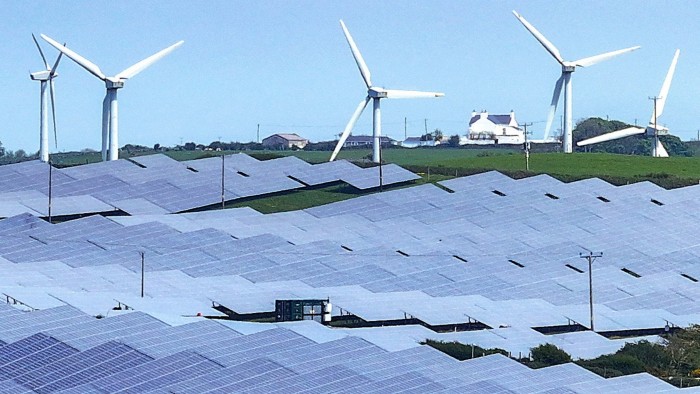Stay informed with free updates
Simply sign up to the UK energy myFT Digest — delivered directly to your inbox.
Britain is on course to fall far short of its targets for developing new solar and wind power despite the government’s efforts to lift barriers and boost the industry, according to new analysis.
Practical hurdles and uncertainty over market reforms mean that the UK is set to miss its clean energy targets by 32 gigawatts, enough to power tens of millions of homes, said consultancy Cornwall Insight in a report.
The findings are a blow to Sir Keir Starmer’s government, which has made decarbonising Britain’s electricity system by 2030 a key goal.
Tom Musker, modelling manager at Cornwall Insight, said the analysis “underscored the urgent need to address both the operational and investment barriers slowing renewables growth.
“Timely investment in infrastructure, clarity on market reforms, and support for innovative project delivery are vital to unlocking the UK’s clean energy potential,” he added.
In order to meet its target of a clean electricity system in five years, the government said last year it wanted the UK by 2030 to have 43-50GW of offshore wind, 27-29GW of onshore wind and 45-47GW of solar power.
At present, the UK has 14.7GW of offshore wind, 15.7GW of onshore wind and 17.6GW of solar power, according to government and industry figures.
However, Cornwall Insight forecast there would be only 37GW of offshore wind, 17GW of onshore wind and 29GW of solar by 2030 — leaving a combined shortfall of 32GW.
Ministers have taken steps to boost conditions for the industry, including lifting restrictions on onshore wind in England, awarding planning permission to new solar farms and increasing the budget for subsidies for renewable energy.
The National Energy System Operator has also acted to cut the time it takes to connect to Britain’s massively oversubscribed electricity grid, including pausing new applications in order to tackle the backlog.
Last week the government also confirmed it would cut the number of times opponents to an infrastructure project can apply for judicial review, after concerns that objections from nearby residents risked delaying new projects.
But Kate Mulvany, principal consultant at Cornwall Insight, said even with such measures “it’s fair to say we are not there yet”.
“The messaging has been strong; there were some very definite decisions during the first month in office,” she added. “But that isn’t the same as getting wholesale planning reform agreed, and given the contentiousness of wholesale planning reform, there is a degree of caution around how rapidly that will ultimately be delivered.”
Developers are also cautious about investing while waiting for the government to decide on whether to push ahead with major potential changes to the electricity market, such as splitting it into different pricing zones, Mulvany added.
To make its forecasts, Cornwall takes into account a range of factors including market sentiment and project announcements. In a similar forecast this time last year, it predicted Britain would have 17GW of onshore wind, 31GW of offshore wind and 21GW of solar by 2030.
Last year’s figures for offshore wind and solar were lower than its new predictions, suggesting the government’s policies will have made some difference.
However, Cornwall cautioned that the forecasts were not directly comparable because of changes to the way it carried out its modelling.
The Department for Energy Security and Net Zero said it did “not recognise” the forecasts, pointing to NESO analysis that showed “clean power by 2030 is achievable”.
“We are cleaning up a dysfunctional grid system to connect the most important projects, speeding up decisions on planning permission and expanding the renewable auction process to stop delays, unlocking growth”.


